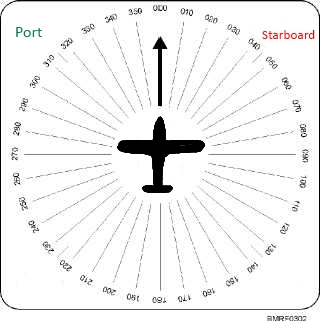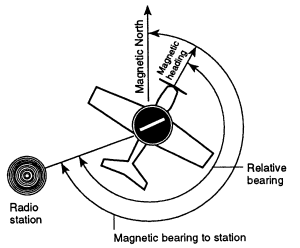Pay Attention Here, Cadet. Wouldn't want you to get lost somewhere over Germany!
Basic Air Navigation
1. Port refers to the left side of the aircraft. The Port side always shows a Red navigation light.
2. Starboard refers to the right side of the aircraft. The Starboard side always shows a Green navigation light.
3. A aircraft's direction or "heading" is expressed in degrees. There are 360 degrees in a full circle.

4. An aircraft's heading or bearing, and other aircrafts' locations, can be expressed as a "Magnetic Bearing" or a "Relative Bearing"
"Magnetic Bearings" use" Magnetic North" (the earth's northern magnetic pole) as the reference point. An aircraft's direction of travel or "bearing" is expressed as the number of degrees away from Magnetic North. As an example. An aircraft headed directly north has a magnetic bearing of 0 degrees. An aircraft headed due east has a bearing of 90 degrees. An aircraft with a magnetic bearing of 180 degrees is headed due south.
An aircraft's "Relative bearings" use the aircraft's nose as a reference point. The direction of the aircraft's travel ( looking straight ahead over the nose) is defined as 0 degrees. All other objects are located relative to this line. An aircraft on the Starboard beam ( to the right of the aircraft, at right angle to it) has a relative bearing of 90 degrees. An aircraft on the Port Beam ( to the left of the aircraft, at right angles to it) has a relative bearing of 270 degrees.
Aircraft can also use radio beacons to help determine its location. If a pilot knows the location of a radio beacon, and its relative bearing, he can use this and the aircraft's magnetic bearing to determine his location.

There are two ways to express a change in an aircraft's heading ( its direction of travel):
1. The pilot can make a change in the aircraft's Magnetic Bearing. For example, if the aircraft has a current Magnetic Bearing of 45 degrees ( that's North East on a compass ) and the pilot wants a turn to the right, he might aim for a new True Bearing of 135 degrees. ( 45 degrees plus 90 degrees) - that's South East on a compass.
2. The pilot can also use the aircraft's Relative Bearing to make a change in direction. He can make a turn to Port or Starboard measured in degrees. For example, a turn to Port might be "Port 90" - a right angle turn to the left.